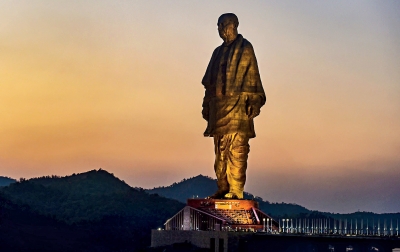
The Statue of Unity is a colossal statue of Indian statesman and independence activist Vallabhbhai Patel (1875–1950), who was the first Deputy Prime Minister and Home Minister of independent India and an adherent of Mahatma Gandhi during the nonviolent Indian Independence movement.
Located on the Sadhu Bet island, near Rajpipla on the Narmada river, the Statue of Unity is located between the Satpura and the Vindhya mountain ranges. A 3.5 km highway will be used to connect the statue to Gujarat’s Kevadia town.
The Sardar Vallabhbhai Patel Rashtriya Ekta Trust (SVPRET), a special purpose vehicle set up by Modi in 2011, arranged some 129 tonnes of iron implements from nearly 100 million farmers in 169,000 villages across all states to construct the base of the statue in the ‘Loha’ campaign. The Statue of Unity will comprise two semi-joined, composite concrete cylindrical cores, surrounded by a structural steel space frame to support the exterior cladding. 5700 Mton of structural steel and reinforcement bars of 18500Mton were used to build the statue.
The statue is a three-layered structure. The innermost layer is made of reinforced cement concrete (RCC), comprising two towers 127 metres high that rise till the statue’s chest. The second layer is a steel structure and the third an 8 mm bronze cladding on the surface. The RCC towers, which at the bottom form Patel’s dhoti-clad legs, have two lifts each. Each lift can carry 26 people to the top in just above half a minute.
Credit : IndiaToday
Picture Credit : Google




